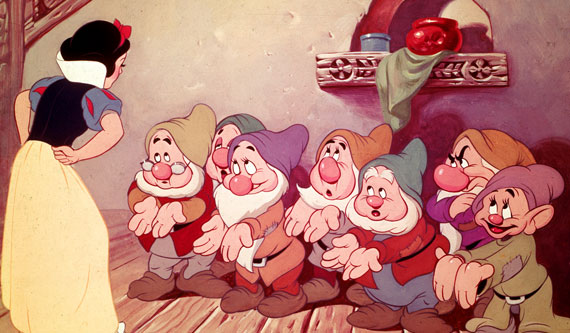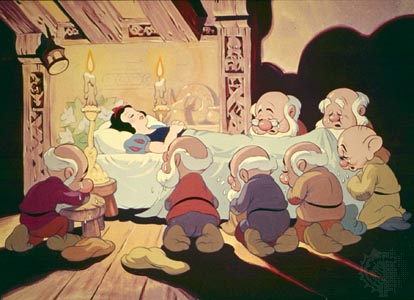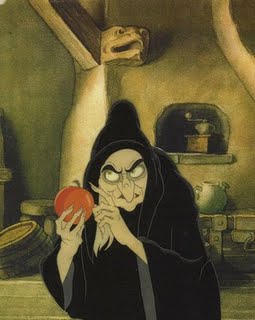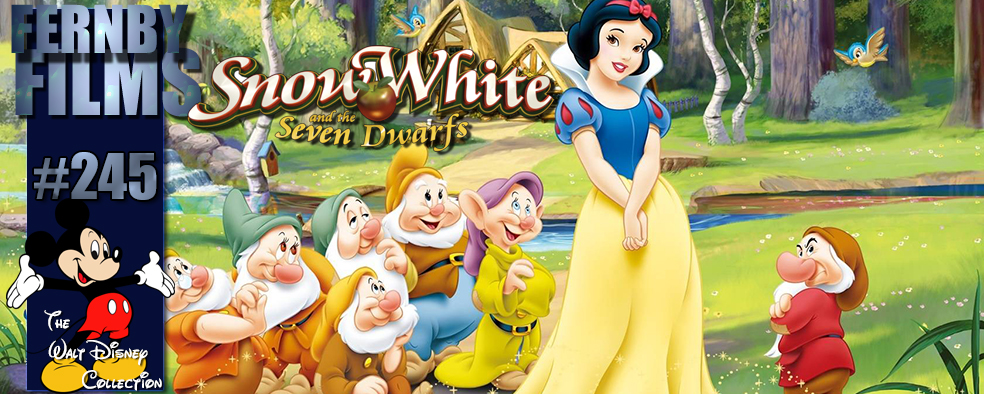Movie Review – Snow White & The Seven Dwarfs
Featuring some of the greatest animation ever to grace the screen, Snow White simply shines in her latest digital incarnation, with fully restored sound and picture. For any serious fan of film, or even for those who are looking to enlarge their film library, this is one of the most important films you must own. The film still entertains, which is all it really needs to do, so buy it, buy it, buy it.
– Summary –
Director : David Hand
Cast : Voices of: Adriana Caselotti, Lucille LaVerne, Roy Atwell, Harry Stockwell, Pinto Colvig, Otis Harlan, Stuart Buchanan, Billy Gilbert, Moroni Olsen.
Year of Release : 1937
Length : 90 Minutes
Synopsis: A young girl befriends 7 tiny men after escaping a murderous plot by the evil Queen.
Review : Featuring some of the greatest animation ever to grace the screen, Snow White simply shines in her latest digital incarnation, with fully restored sound and picture. For any serious fan of film, or even for those who are looking to enlarge their film library, this is one of the most important films you must own. The film still entertains, which is all it really needs to do, so buy it, buy it, buy it.
********************
There’s great films, and then there’s Snow White. Arguably one of the most influential films ever made, aside the first ever talkie in The Jazz Singer, and the first films to make use of computer graphics, Snow White was a trailblazing film that set the standard for all that followed. Hyperbole aside, Snow White remains an enduring icon and legacy from both the early days of Disney, and the beginnings of Hollywood itself, remaining the defining benchmark for animation ever since.
The legendary story of Snow White and Disney has been told and retold in the decades since it’s 1937 release, so recounting the specifics of the story would be redundant here. In the 70+ years since the film came out, it’s merits and qualities have been examined, assessed and espoused numerous times in numerous formats, all of which have come to the conclusion that the film is among the greatest examples of storytelling ever made.
Looking at the newest DVD release from the Disney vault, that fascinating example of marketing that provokes the desired reaction in film lovers around the world, Snow White still stands the test of time, from it’s amazing animation style to the simple, elegant narrative of a young girl hunted by an evil Queen who seeks to remain the “fairest in the land”, according to the eponymous magic mirror. With some breathtaking visuals along the way, a soundtrack filled with songs that have entered the very cultural fabric of our world and that most people will sit there saying “oh is that song from this film?”, Snow White is truly the pinnacle of animated films, at least until the release of The Lion King in 1994.

In the early 30’s, Disney’s success with his animated short films had given him enough confidence to set about making the first ever full length animated feature, an enterprise which shocked and amazed Hollywood, and led to a number of publications within the industry denouncing the project as doomed to failure. After all, how many people would want to sit through a 90 minute cartoon? Supposedly, people would not be able to take in all the colors and action a cartoon could provide, and the story wouldn’t hold interest long enough to warrant such a film. Disney, however, in his way, persevered in spite of the industry opposition, leading to the most anticipated film premiere of the decade. We all know how successful Snow White ended up being, with successive re-releases no less that five times since it’s original theatrical run. The Disney Studio became the juggernaut it currently is based on the success of that first feature film, and while quality films were a little hit and miss in the years between then and now, ultimately, the studio can thank it’s lucky stars Snow White was as successful as it was. Without it, I doubt Disney would be in the place it is now.
So how well does Snow White stand up under modern scrutiny, nearly three quarters of a century since it first appeared? You’d be surprised, considering many live-action films of a similar vintage are almost unwatchable by comparison. Snow White is still an entertaining film, however it’s perhaps less “exciting” by comparison to the CGI and pop-culture savvy affairs pouring from Dreamworks, Pixar and Fox these days. Watching Snow White, I think the makers of the Shrek films owe a lot to Disney’s creation, considering the amount of material they stole and riffed-on to make their mega-hit film a few years back. Snow White is a simple story: a young princess is made to work as a scullery maid by the evil Queen, who resents Snow White’s beauty. When the Queen decides Snow White must die, the man assigned to the mission succumbs to a change of heart and lets the girl go, to flee into the woods, where she meets up with seven tiny miners living in slovenly conditions. She befriends the dwarfs, and sets about adding a female touch to their lives, which they initially resent but eventually warm to. Meanwhile, the evil Queen discovers that Snow White is not dead, and using magic, turns herself into an old crone, and seeks Snow White to poison her with an apple dipped in.. well… poison. Of course, the poison is intended to put Snow White into an eternal sleep, only to be awoken on the off chance that loves first kiss comes along.

Plot logic gaps aside (such as, why doesn’t the queen simply feed Snow White some arsenic and kill her off permanently…. why the need to allow a get-out-of-jail card like “loves’ first kiss”?) Snow White follows the fairy story standard almost perfectly. Snow White is beautifully rendered, her perfect skin and unmatched beauty still dazzling to this day. My wife told me after watching the film again that she found the voice of Snow White (voice of Adriana Caselotti) to be somewhat annoying, and truthfully, I tended to agree with her. Caselotti’s voice was probably okay for the age bracket Snow White is at the time the film is set, but her softly spoken husk limits the ease to which the audience can listen to her. Caselotti imbues Snow White with a sense of virginity (as if Disney would allow anything less!) and innocence, however vocally, she tends towards being too softly spoken for my liking. Lucille LaVerne, voicing the vindictive Queen, is considered now to be the template for almost every screen villainess that would follow. Vocally, LaVerne is superb, her icy demeanor as the Queen giving way to the raspy, crone-vocals she uses when the plot develops during the films second half. She’s the very definition of evil, although, if I can be a tad hyper-critical of the film, she’s somewhat underdeveloped as a character; although, in hindsight, perhaps I am too modern in my thinking of films to consider that for it’s time, she was the personification of all that is evil, and that you din’t really need to define a character by much more than a glare and wicked laugh. Still, it’s fair to say that the Queen, along with almost all the characters in the film, have extremely limited backstory, meaning that effectively they remain the cliched stereotypes that we have all grown up with.
With Disney getting Snow White into the forest and up with the company of dwarfs (I would normally type dwarves here, but since Disney himself used the Americanized version, I will do so as well, for the sake of simplicity) quite quickly, we can get to meet our short-statured friends in relatively short order. And yes, that’s a short joke. Sorry. And when the dwarfs appear on screen, the film actually improves as it goes along. For it appeared to me when watching this film again that the dwarfs were given the most attention when it came to anything resembling character development. While each of the seven little guys are limited in the screen time they have, or the dialogue they have, each of them definitely lives up to their individual names, especially Dopey and Grumpy, my own personal favorites. The slapstick-schtick of the dwarfs meeting Snow White is still quite amusing today, with eternal clown Dopey drawing the most laughs. Of course, the sexism in Snow White & The Seven Dwarfs is blatantly obvious: Snow White arrives at the dwarfs cottage to find it quite manly-untidy, with dust, spider-webs and dirty dishes strewn around the place. Quick-smart, she get’s to cleaning, although most of the hard labor is carried out by the un-thanked animals of the forest, who come to help our fair maiden get the job done. Throw in a bunch of workman-like gags at the expense of the female gender, and you have a film synonymous with community standards of the time. In a little side note, my canny wife also remarked that had she been the next person to eat from a plate washed by the wet tail of a forest dwelling deer, or squirrel, she’d probably vote to go hungry. Overlooking the conventions of animation and storytelling, I’d agree with her. But the moment is charming, a captivating Disney cliche that heralded the mainstreaming of anthropomorphic animals in human areas of expertise, for which Disney would become famous. But the dwarfs addition to the film, with their famous “Heigh Ho” song as way of entrance, is still enchanting to this day, and while the audio can only be cleaned up so much, the quality of the song is still undeniable.

In fact, musically, this film is an absolute goldmine for film fans. Almost every single song is recognizable as a classic, much riffed and often pilfered by the Disney corporation to whore their brand out in the marketplace. From “Whistle While You Work”, to “Some Day My Prince Will Come” and “I’m Wishin'”, every song is instantly hummable and immediately recognizable. Thankfully the DVD audio has been restored to as pristine a condition as possible for a film of this vintage, and while the overall effect may reek of 1930′ production value, the films score has a vibrancy and immediacy that ensures each track is as vital as the day it was released. The extended musical sequences that dot the film, and in particular a rather long dancing scene with the dwarfs and Snow White, abound with a radiant energy, even if the plot tends to become a little stretched by the time this starts to happen. By modern standards, the film does tend to become a little long-winded, a slightly sagging middle third which does nothing but prolong the wait for the evil Queen to do her thing. The dwarfs get to hamm for the audience, and while initially this is quite cute, unfortunately as far as structure of the film goes, it begins to drag after a while. The films conclusion, however, with the evil Crone being pursued by the dwarfs up and up the side of a craggy peak, is definitely exciting, and restores the exemplary pacing and story beats the film begins with. The middle act is perhaps the weakest part of the entire film, and while perhaps slight sacrilegious to say, by today’s standard (after all, that’s all I can compare it to) it’s a little bloated and (gulp) unnecessary.
Considering that Snow White was the blue-print for such pop-culture refits like the Shrek films, in which everything Disney ever did was somehow modernized and lampooned, almost every scene in Snow White can be recognized as it’s accompanying scene in Shrek and it’s ilk. The famous “Princess sings with a bird” (until it explodes) routine in Shrek was borne out of an identical scene in Snow White. The smart-ass Magic Mirror from Shrek is a carbon copy of the version here, minus some of the smoke. There’s cultural references everywhere in Show White, and you may even lose focus on the film itself spotting them all. Don’t be put off, though, because for all it’s 30’s limitations, Snow White as a film stacks up pretty damn well with the current crop of animated dreck.
Technically, what Walt and his team achieved with Snow White is mind-boggling. The first ever film to be shot in Technicolor, a format still used today (although now slightly more advanced). The first animated film of any kind to use multi-plane technology, where the background were photographed over various levels of focus to give a more 3D look to the picture. The cell animation was among the most detailed and refined (to that time) ever produced for an animated work. And all the way along, Disney was pilloried for even attempting to do what he did. Later, though, he’d have the last laugh. Disney’s success with Snow White was unparalleled, perhaps the Titanic of it’s time, so much so that even to this day, the film keeps being reissued into cinemas around America from time to time. The remastered version available now has the latest digital audio restoration, remixed into surround sound, as well as a super-crisp picture restoration that makes this film simply shine, looking like it was only made yesterday, not 75-ish years back.
Snow White remains the enduring legacy Walt Disney brought to the world. Defining animation, wonderful production values and a sense of style never really attained since by the studio, if you do not own a digital copy of Snow White in your movie collection, then you need slapping. A little dated by today’s shiny, pop-culture standards, but as far as simple, elegant entertainment goes, you will not find a better film than this one to enthrall the kids, or your parents. Defining, spectacular, and still brilliant, Snow White really is the fairest one of all.











